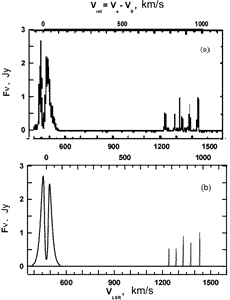Physics of Active Galactic Nuclei
The nature of the active galactic nuclei (AGN) is one of the most
important problems of the today astrophysics. By now the AGNs are usually thought to be
supermassive black holes with masses of millions or even billions of
solar masses. The high energy release is explained by accretion of the ambient matter
onto their gravitational centers.
A model for H2O-maser source observed in the circumnuclear region
of the acdtive galaxy NGC 4258 is developed. The maser emission of wavelenght
1.35 cm originates at distances of 0.15-0.30 pc from the center, in a thin
molecular accretion disk (gas-dust torus) rotating around a supermassive black hole
of mass about million solar masses.
Considerable progress in elucidating the nature of active
galactic nuclei has become evident in connection with
a radiointerferometric study of the H2O maser emission
from the nuclear region of the giant spiral SABbc galaxy
NGC 4258 (M 106) located at the distance D~7.3 Mpc.
The galaxy has a complex structure with inner and outer
spiral arms, a dust lane, and jets, which are
observed both in the optical and radio
ranges. By the characteristic appearance of its optical
spectrum, NGC 4258 was initially classified as a Seyfert 2
galaxy or, more precisely, as Sy 1.9. Subsequently, it was
classified as belonging to the subgroup of the so-called
LINERs (Low Ionization Nuclear Emission Region).
The total luminosity L of the nucleus of this galaxy
is 1042-1044 erg s-1. Since the galaxy nucleus
itself is completely obscured by a gas-dust disk
it can be observed optically only in scattered linearly
polarized light. Accordingly, the emission as viewed
by the observer is mainly concentrated in the near infrared.
However, X-ray emission with a luminosity
of about 4.4*1040 (D/7.3 Mpc)2 erg s-1 was detected
in the (3-10) keV band.
NGC 4258 is unique in that the line of sight lies virtually
in the plane of the molecular gas-dust accretion disk.
That is why we can observe the maser emission from the disk.
In this study, an attempt is made to restore the structure
of the accretion disk by comparing observational data with
calculations of the intensity of the maser emission.
We were able to do this, because both the intensity and the
spectral line profile are highly sensitive, first,
to the number density and temperature of the H2O working
molecules and H2 buffer gas and, second, to the geometry
of the system and the gas velocity field, whose gradient
determines the amplification path length before the
emergence from resonance, 1014-1015 cm.
 The H2O maser emission from the nucleus of NGC 4258
was first detected by Claussen; however, the first spectra were
obtained in a narrow range of frequencies (velocities) corresponding
to the central, most intense components of the maser line.
Only a decade later did Nakai measure the spectrum in a wider
frequency range and detected high-velocity components
to the right and to the left of the central line.
Three hypotheses about the nature of the high-velocity components
of maser emission were proposed:
The H2O maser emission from the nucleus of NGC 4258
was first detected by Claussen; however, the first spectra were
obtained in a narrow range of frequencies (velocities) corresponding
to the central, most intense components of the maser line.
Only a decade later did Nakai measure the spectrum in a wider
frequency range and detected high-velocity components
to the right and to the left of the central line.
Three hypotheses about the nature of the high-velocity components
of maser emission were proposed:
a bipolar jet,
nonlinear scattering in a dense plasma, and
a molecular disk [6].
The nature of these components was finally elucidated
only after VLBI measurements, which yielded a
high-angular-resolution map of the spatial distribution
of maser subsources.
An analysis of the interferogram revealed that the high-velocity
components of the maser line arise in the right and left
wings of a thin molecular disk (gas-dust torus) seen edge-on.
Moreover, the maser features turned out to fall nicely
on the Keplerian radial-velocity curve.
The maximum and minimum rotation velocities of the maser features
are Vmax=1080 km/s and Vmin=770 km/s;
the radius R [in] of the inner maser subsource corresponding
to Vmax is 0.15 pc (D/7.3 Mpc),
whereas the radius R [out] of the outer subsource corresponding
to Vmin is 0.29 pc (D/7.3 Mpc).
Owing to these measurements, the central mass inside the disk
was determined for the first time with a high accuracy:
M=4.0*107Mx(D/7.3 Mpc).
The only explanation for the existence of such a
large mass in such a small region is the presence
of a supermassive black hole.
 The H2O maser emission from the nucleus of NGC 4258
was first detected by Claussen; however, the first spectra were
obtained in a narrow range of frequencies (velocities) corresponding
to the central, most intense components of the maser line.
Only a decade later did Nakai measure the spectrum in a wider
frequency range and detected high-velocity components
to the right and to the left of the central line.
Three hypotheses about the nature of the high-velocity components
of maser emission were proposed:
The H2O maser emission from the nucleus of NGC 4258
was first detected by Claussen; however, the first spectra were
obtained in a narrow range of frequencies (velocities) corresponding
to the central, most intense components of the maser line.
Only a decade later did Nakai measure the spectrum in a wider
frequency range and detected high-velocity components
to the right and to the left of the central line.
Three hypotheses about the nature of the high-velocity components
of maser emission were proposed: